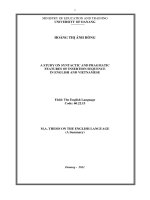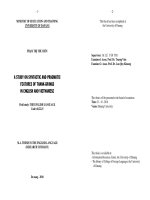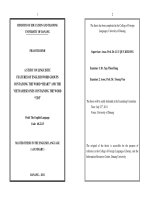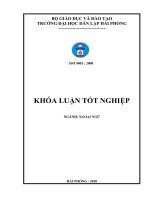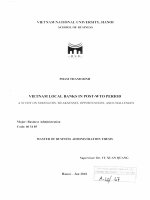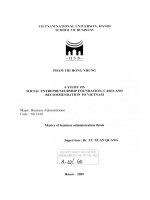A study on syntactic, lexical semantic and rhetorical features of word groups containing words denoting seasons in vietnamese and english
Bạn đang xem bản rút gọn của tài liệu. Xem và tải ngay bản đầy đủ của tài liệu tại đây (80.57 KB, 13 trang )
1
2
MINISTRY OF EDUCATION AND TRAINING
Chapter 1
DANANG UNIVERSITY
INRODUCTION
******
1.1. RATIONALE
We all know that Word groups can not be deficient in
communication. And when studying a language, we cannot ignore
CAO THI VAN
word groups (combinations), because we sometimes come cross
some phrases or word groups that we cannot understand inspite of
comprehending the meaning of each constituent word. Thus, it is
important to know how to use word groups containing words
A STUDY ON SYNTACTIC, LEXICALSEMANTIC AND RHETORICAL FEATURES
OF WORD GROUPS CONTAINING WORDS
DENOTING SEASONS IN VIETNAMESE
AND ENGLISH
denoting seasons (WGCWSs) in different languages.
WGCWSs, especially are used much in Vietnamese poetry
and literature. These word groups have different syntactic, semantic
and rhetorical features depending on the attitude, purposes or the
style of the writers and speakers. In English WGCWS are also
another problematic issue.
Therefore, “A Study on Syntactic, Lexical-Semantic and
Rhetorical Features of Word Groups Containing Words Denoting
Major: ENGLISH LANGUAGE
Code: 60.22.15
Seasons in Vietnamese and English” is selected as the title of my
M.A thesis.
1.2. AIMS AND OBJECTIVES
1.2.1. Aims of the Study
The aims of the thesis “A Study on Syntactic, Lexical-
MASTER THESIS IN THE ENGLISH LANGUAGE
(A SUMMARY)
Semantic and Rhetorical Features of Word Groups Containing
Words Denoting Seasons (WGCWSs) in Vietnamese and English are:
- to find ways of collocation of WGCWSs in Vietnamese and
English.
DANANG, 2011
3
- to find out the main similarities and differences of WGCWSs
4
groups containing words denoting two seasons- spring and autumn-
in Vietnamese and English in terms of syntactic, lexical-semantic
in poems in Vietnamese and English.
and rhetorical features.
1.5. SIGNIFICANCE OF THE STUDY
1.2.2. Objectives of the Study
The objectives of the study are:
WGCWSs in Vietnamese and English are those with high
frequency of occurrence. Being aware of similarities and differences
- To describe, classify, compare and analyze the syntactic,
in using them, hopefully will widen learners’ a deeper and better
lexical-semantic and rhetorical features of WGCWSs in Vietnamese
understanding of WG, help to increase learners' awareness about
and English.
significant similarities and differences between WG of two
- To work out the ways to develop awareness of WGCWSs for
languages, avoid unnecessary mistakes caused by interlingual
the readers and help them better their competence in communicating
interferences in their writing, speaking and translation, and enhance
and translating.
their abilities to use them appropriately and communicatively in
- To make suggestions for the problems learners may
encounter in the process of teaching, learning and translating
different circumstances.
1.5. DESIGN OF THE STUDY
WGCWSs into English.
The study consists of five chapters:
1.3 RESEARCH QUESTIONS
- Chapter 1, Introduction, includes the rationale, aims and
To achieve the aims and objectives of the study, the following
research the following questions are raised:
1. What are the syntactic, lexical-semantic and rhetorical
features of WGCWSs in Vietnamese?
2. What are the syntactic, lexical-semantic and rhetorical
features of WGCWSs in English?
3. What are the differences and similarities of WGCWSs in
Vietnamese and English in terms of syntactic, lexicalsemantic and rhetorical features?
1.4. SCOPE OF THE STUDY
objectives of the study, scope of the study, significance of the study,
research questions and design of the study.
- Chapter 2, Literature Review, concentrates on two main
issues including a review of previous studies related to the research
and some theoretical background dealing with the general concepts of
words, word groups, phrases related to definition terms such as lexis,
syntax, semantics, rhetoric and so on are clarified in this chapter.
- Chapter 3, Methods and Procedures, describes the
research design, the procedures of data collection and the validity and
reliability of the study.
This research focuses on presenting, describing and analyzing
- Chapter 4, Findings and Discussions, the most important
of the syntactic, semantic and metaphoric semantic features of word
part in the study, describes, analyzes and discusses WGCWSs in
5
6
Vietnamese and English in terms of syntax, semantics and rhetoric.
for realizing word groups by combining words with words, and he
It is subdivided into the following sections:
also mentioned different types of word groups. Diep Quang Ban [2]
+ The syntactic features of WGCWSs in Vietnamese and
English
studied the syntactic, and semantic characteristics of combinations.
In English, Gleason [35] had studies of the word structure,
+ The lexical-semantic features of WGCWSs in Vietnamese
and English
especially gave the definitions of single words and compound words.
Rodman, Odman, Collins, Blair [57] studied classes of words, rules
+ The rhetorical features of WGCWSs in Vietnamese and
English
of word formation. Yule [61] widened his study about words and
word-formation processes, parts of speech, phrase structure rules,
+ Similarities and differences
lexical rules and lexical meaning. Arnold [19] showed his detailed
- Chapter 5, Conclusion, comprises the summaries of main
points of views about English words, especially about characteristics
findings and suggestions for further research.
of the word, lexical meaning and semantic structure of English
words, compound words and set expressions. Biber et al. [24]
Chapter 2: LITERATURE REVIEW AND THEORETICAL
discussed phrases and offered the definition of phrase and its
BACKGROUND
characteristics, especially, they showed and analyzed the types of
Besides the review of previous studies, the author of the
phrase. Quirk et al. [56], Richards et al. [58], Rodman et al. [57]
thesis offers basis theoretical preliminaries as follows:
studied the types of phrase, the phrase structure rules and indicated
2.1. OVERVIEW
meaning aspects of phrases.
This chaper deals with the previous studies related to the
thesis. Besides, the theoretical background about the word and word
groups and some rhetorical features are chosen for the theory of this
2.3. THEORETICAL BACKGROUND
2.3.1. Definitions of Word
According to Richard et. al. [58, p.406], “word: the smallest of
research.
the linguistics units which can occur on its own in speech or
2.2. A REVIEW OF PREVIOUS STUDIES RELATED TO THE
writing”.
RESEARCH
According to Fromkin [32, p.25], “Words are meaningful
Word groups (phrases) have been studied by many researchers
linguistic units that can be combined to form phrases and sentences”.
and discussed in many grammar books by famous authors in both
Biber D. et al [24 p.51] state, “To the ordinary language user,
Vietnamese and English.
In Vietnamese, Nguyen Tai Can [6] made distinctions between
single words, compound words and phrases. He mentioned the ways
words are the basic elements of language. They are clearly shown in
writing; they are the units which dictionaries are organized around.”
7
8
2.3.2. Classification of Words
According to Vietnamese linguists, in general, the word is
classified into three kinds: single words, complex words and
A lexical field as suggested by Jackson [41, p.14], is a set of
lexical items related in meaning and arrayed to display the
similarities and differences between the items.
reduplicative words.
According to the point of Rodman and Blair [57, p.132],
In short, lexical field, according to Richard et. Al. [58, p.211],
is “the organization of related words and expression into a system
Parker and Riley [53, p.103], Plag [55, p.10], words can be classified
which shows their relationship to one another”.
into single words and complex words.
2.3.6. Word group
2.3.3. Word Formation
2.3.6.1. Definitions
As stated by O’Grady [52, p.120], two most common types of
As stated by Arnold [19, p.165], a WG consists of two or
word formation are derivation and compounding, both of which
more words whose combination is integrated as a unit with a
create new words from already existing morphemes.
specialized meaning of the whole, such as the spring unmoved , with
2.3.4. Word Meaning
the wild spring rain, autumn colors, and so on.
2.3.4.1. Classification
There are two main types: direct meaning and indirect
According to Diep Quang Ban [3, p.5], words organizationally
and meaningfully combined together are WG. Each word in WG is
meaning.
an element.
2.3.4.2. Semantic Properties
2.3.6.2. Classification of Word group
According to Leech [45, p.26], Nguyen Hoa [50, p.51], Vo Dai
Quang [60, p. 27], there are four main components of word-meaning.
According to Downing and Locke [29] and Quirk and
Greenbaum [56], WG can be classified into the following groups.
a. Denotative Meaning
b. Connotative Meaning (or social, affective)
Norminal groups such as “a solemn autumn, the autumnal
sun”.
c. Structural/ Associative Meanings
d. Categorial Meaning
Verbal groups like “thought of springt, cut away the heart of
mine”.
2.3.5. Lexical Field
According to Jackson & Amvela [41, p.14], ‘semantic field’
or ‘semantic domain’ are used alternatively for the terms ‘lexical
field’ or ‘lexical set’.
Adjectival groups such as “deep in my heart, successful in your
life”.
Prepositional groups such as “in autumn, from the autumn
bonfires”.
9
10
Acoording to Nguyen Tai Can [7, p.96] divides WGs into
on theories and dealt with those of word groups. In addition, the
three kinds. Those are norminal groups, verbal groups and adjectival
definitions and classifications of metaphor have been focused on.
groups.
Semantically, we have relied on the theories of many linguists, such
2.3.7. Rhetoric
as Richard et. al., Quirk et. al., Cruse, Galperin, Diep Quang Ban,
2.3.7.1. Definitions of Rhetoric
Nguyen Tai Can, Cu Dinh Tu,… and gave concepts as definitions of
According to Galperin I.R. [34, p.191], rhetoric was mainly
word and word group, classification of word and word group, word
engaged in the observation of the juxtaposition of the members of the
meaning, semantic properties, lexical field, definitions of metaphor
sentence and in finding ways and means of building larger and more
and classification of metaphor. All serve investigating WGsWS in
elaborate spans of utterance.
syntactic, lexical-semantics and rhetorical features in the next
The scope of the study of this thesis only mention to metaphor
chapter.
in the word groups containing word denoting season- spring and
autumn. Thus, we will take out the definition of metaphor.
Chapter 3
2.3.7.2. Definitions of Metaphor
As stated by Brooks, C. et. al. [25, p.274] ‘In metaphor there is
METHODS AND PROCEDURES
3.1.
OVERVIEW
a transfer of meaning – the Greek word from which metaphor is
This chapter focused on the methods and procedures of
derived means “to transfer”. A word that applies literally to one kind
studying the thesis. It also dealt with how data were collected,
of object or idear is applied by analogy to another’.
presented, described and analyzed to reach the expected results.
According to Galperin [34, p.139], the stylistic device based on
3.2.
RESEARCH DESIGN
the principle of identification of two objects is called a metaphor.
This paper aims at investigating WGCWSs in Vietnamese and
And he adds “it is better to define metaphor as the power of realizing
English in terms of their syntactic, semantic and rhetorical features.
two lexical meanings simultaneously”.
In order to achieve the aims and objectives of the study mentioned in
As defined by Dinh Trong Lac [14, p.52] and Cu Dinh Tu [18,
chapter 1, descriptive, analytical and constrastive methods were
p.279], metaphor is the way using this object to refer to that object
employed to do the research.
basing on the relation of association about the similar characteristic
3.3. POPULATION AND SAMPLES
between two objects.
The target population is intended to reach eight hundred
2.4. SUMMARY
We
have
patterns from Vietnamese and English materials. This is total number
so far
discussed syntactic and semantic
characteristics of words. Syntactically, we have continued focusing
of an entire group including WGCWSs extracted from famous
11
12
poems, short stories, literary works in Vietnamese and English. These
patterns are also an available source of samples for the study.
3.7. RESEARCH PROCEDURES
3.4. INSTRUMENTS FOR DATA COLLECTION
The procedures for the study will be as follows:
To the extent of descriptive research, observation and
- Collecting and classifying data
investigation are methods of collecting data. Observation and
- Analyzing data
investigation techniques can be part of qualitative research as well as
- Comparing and contrasting
quantitative research techniques.
- Putting forward some implications for teaching and learning
3.5 DATA COLLECTION
This research was restricted to commonly-used WGCWSs in
Vietnamese and English poetry. Data for this research were collected
English as well as for translating WGCWSs and giving suggestions
for further researches.
3.8. RELIABILITY AND VALIDITY
from different types of poem works in Vietnamese and English. The
Usually, the validity provides information on the extent to
data provided a detailed description of how WGCWSs used in
which the procedure really measures what it is supposed to do. The
different contexts. They also provided illustrations to clarify the
reliability provides information on the extent to which the data
study.
collection procedure elicits accurate data.
3.6. DATA ANALYSIS
3.9.
- Observing the corpus and finding out the general meanings of
WGCWSs
- Classifying WGCWSs into suitable categories corresponding
with each syntactic feature by means of analytical and descriptive
SUMMARY
The study must follow the research design strictly. The data
collection procedures and research instruments must be performed
carefully and adequately in order to obtain the quality, the validity
and the reliability of the work.
approaches and shades of meaning denoted by WGCWSs in
semantics to be identified.
Chapter 4
- Describing and analyzing the samples fully by the analytical
and descriptive methods.
FINDINGS AND DISCUSSIONS
4.1.
OVERVIEW
- Clarifying and illustrating the shades of WGCWSs in various
This chapter foscused on analyzing syntactic, lexical-semantic
contexts to highlight the syntactic, semantic and rhetorical properties
and rhetorical features of WGCWSs in order to find out the
of WGCWSs.
similarities and differences in both languages.
- Examining the differences and similarities of WGCWSs in
syntactic, semantic and rhetorical features.
13
4.2.
SYNTACTIC
FEATURES
14
OF
WORD
GROUPS
CONTAINING WORDS DENOTING SEASONS (WGCWSs) IN
nouns, verbs, adjectives and numerals. Let see this cases in the
examples from (4.16)
VIETNAMESE AND ENGLISH
a3) Word Group “X + Xuân + Y”
4.1.1. Syntactic Features of Vietnamese Word Groups Containing
While classifying and analyzing this word group, we see that
Xuân/Thu
the words in front of xuân are usually noun, quantifier, and verb. And
4.2.1.1. Syntactic Features of Vietnamese Word Group Containing
the word behind xuân are adjective, determiner, verb, adverb,
only Xuân/Thu
quantifier. The illustrations from example (4.29) to 4.43) show this
In this part, the word xuân/thu is considered as a single word
case.
when it occurs without preceeded elements (pre-modifiers) and back
b) Word Group Containing Thu (WGCT)
ones (post-modifiers). the simple word xuân/thu can stand
b1) Word Group “X + Thu”
independently with the great quantity.
We infer the following result from analyzing the samples: most
In Vietnamese, however, there are no phenomena of either
inflection or derivation. Let us have a look at the following examples:
(4.1) Xuân c a ñ t tr i nay m i ñ n
Trong tơi, xn đ n đã lâu r i
adjectives, verbs. Let examine the examples from (4.46) to (4.60).
b2) Word Group “ Thu + Y”
[73, p.16]
(4.2) Ngư i ñ p ñi trên ph
Thu trên t ng búp tay.
words occuring in front of thu are quantifiers, numeral, nouns,
After classifying and analyzing the samples of this word
group,
[66, p.110]
we infer that the words occuring behind thu are mainly
determiners, adverbs, adjectives and verbs. Let us have a look at the
4.2.1.2. Syntactic Features of Vietnamese Word Group Containing
examples from (4.61) to (4.67).
Xuân/Thu and Other Words
b3) Word Group “X + Thu + Y”
a) Word Group Containing Word Xuân (WGCX)
The samples of this word group rarely appear when collecting
a1. Word Group “Xuân + Y”
the data. And in analyzing samples, we see that the words occur in
When analyzing the samples, we see that the words following
this form are usually nouns, adjective, determiners, quantifiers and
xuân are usually adjectives, nouns, verbs, determiners, numerals. Let
adverbs. Let have a look at the examples from (4.68) to (4.73).
examine the examples from (4.4) to (4.15)
4.2.2. Syntactic Features of English Word Groups Containing
a2) Word Group “X + Xuân”
Spring/Autumn
When analyzing samples of word group “ x + xuân”, we infer
that most of the words appearing in front of xuân are quantifiers,
4.2.2.1. Syntactic Features of English Word Groups Containing
only Spring/Autumn
15
As we see, word groups containing only spring/autumn appear
16
b1) Word Group “X + Autumn”
without preceeded elements (pre-modifiers) or followed ones (post-
The words appearing in front of autumn analyzed are articles,
modifiers), so they are considered as the single words, for example,
adjectives, nouns, prepositions, determiners, ordinal numerals and
(4.74), (4.75) and (4.76)
numerals. Look at the examples from (4.121) to (4.136)
Unlike the word xuân/thu, suffix as -al, can be added to
“spring/autumn” and they are not required by the grammar, they
b2) Word Group “ Autumn + Y”
Like the form ‘Spring + Y’, the form of word group ‘Autumn +
increase the vocabulary and may allow speakers to convey their
Y’ is rare, the words appearing behind autumn are mainly nouns.
thoughts in a more interesting manner.
b3) Word Group “X + Autumn + Y”
Besides, the inflectional morpheme –s can also be added to the word
According to our analysis and classification, the words
spring/autumn to modify its number and aspect without changing its
standing in front of and behind autumn in this word group are usually
grammatical category. This case also does not appear much.
articles, adjectives, nouns, prepositions, determiners, ordinal
4.2.2.2. Syntactic Features of English Word Groups Containing
numbers, possessive pronouns and gerunds. Let us look at the
Spring/ Autumn and Other Words
illustrations from (4.141) to (4.157)
a) Word Groups Containing Spring (WGCS)
4.3. LEXICAL-SEMANTIC FEATURES OF WORD GROUPS
a1) Word Group “X + Spring”
CONTAINING
Most of the words in front of spring are usually articles,
adjectives, nouns, quantifiers,
prepositions, possessive adjectives
WORDS
DENOTING
SEASONS
IN
VIETNAMESE AND ENGLISH (WGCWSs)
4.3.1. Lexical-Semantic Features of Vietnamese Word Goups
and determiners. Let us examine the examples from (4.80) to (4.101).
Containing Xuân/Thu
a2) Word Group “Spring + Y”
4.3.1.1. Lexical-Semantic Features of Vietnamese Word Groups
The words which occur behind spring are mainly nouns in the
examples from (4.102) to (4.105). In the data collected the word
group ‘Spring + Y’ rarely appear.
a3) Word Group “X + Spring + Y”
When analyzing samples we have inferred the result: most
Containing only Xuân/Thu
a) Word Groups Containing only Xuân (WGCX)
“Đ i T Đi n Ti ng Vi t” [79, p.1874] shows that xuân has
5 senses: mùa ñ u tiên c a năm, trư c mùa h ; năm; thu c v tu i
tr ; thu c v tình u; dùng đ ví v i ngư i cha, m .
words appearing in front of and behind spring are usually articles,
From the senses above, we have seen that semantic
adjectives, nouns, prepositions, determiners and ordinal numerals.
characteristic of word groups containing xuân only (WGCX) has
Let examine the examples from (4.106) to (4.120
senses: the first season of a year - the season prior to summer and
b) Word Groups Containing Autumn (WGCA) and Others
lunar new year.
17
18
- Denoting the sense ‘the first season of a year’
(4.3) Xuân ñ n năm nay, s m l thư ng
When analyzing the samples, we can see the following
[69, p.263]
- Denoting the sense ‘lunar new year’
(4.4)
Xuân nay xuân năm thìn
semantic features of the word thu related to the meaning of word
group containing it as follows:
[72, p.422]
- Sense related to season in a year
b) Word Goups Containing only Thu (WGCT)
- Sense related to year
“Đ i T Đi n Ti ng Vi t” [79, p.1592] shows that thu has 2
- Sense related to scenery of autumn
senses: a season transiting from summer to winter- a third season in
b1) Word Group “X + Thu”
a year; and denoting year.
b2) Word Group “Thu + Y”
In this part, the single word thu expresses one sense such as a season
b3) Word Group “X + Thu + Y”
changing from summer to winter – the third season in a year.
(4.5) Lòng êm như chi c thuy n trên b n
Nghe rét thu v h b t mui…
These word groups express mainly the meaning related to
‘season’ and ‘scenery in thu’
[62, p.117]
4.3.2. Lexical-Semantic Features of English Word Groups
4.3.1.2. Lexical-Semantic Features of Vietnamese Word Groups
Containing Spring/Autumn
Containing Xuân/Thu and Other Words
4.3.2.1. Lexical-Semantic Features of English Word Groups
a) Word Groups Containing Xuân (WGCX) and Others
Containing only Spring/Autumn
The word groups containing xuân have four following senses
a) Word Groups Containing only Spring
- Senses related to season, first season in a year
According to the website ‘Think Map’ and Hornby [36, p.1152], the
- Senses related to year
- Senses related to the scenery of spring
word spring has a lot of senses, but this thesis is confined to word
groups containing word denoting season. Therefore, the word spring
- Senses related to “Lunar Tet holidays”, the first days of the lunar
with the sense related to was the
year
first season of the year was investigated. For example:
a1) Word Group “X + Xuân”
(4.5)
When spring returns she’ll well acquit the loan
a2) Word Group “Xuân + Y”
a3) Word Group “X + Xuân + Y”
The word groups above are majority expressing the senses
[80, p.222]
b) Word Groups Containing only Autumn
From the website ‘think map’ and Hornby [79, p.69], we have
‘scenery of xuân’, ‘year’ and ‘season’
seen that the word spring has many senses but in this research, the
b) Word Groups Containing Thu (WGCT) and Others
word autumn has one sense, it is the meaning of the third season of
the year, coming between summer and winter. For example:
19
20
(4.6) Leave the last labors to the parent sun;
4.4.1. Metaphorical Features of Vietnamese Word Groups
Beneath his genial smiles, the well-drest field,
Containing Xuân/Thu
When autumn calls, a plenteous crop shall yield.
4.4.1.1. Metaphorical Features of Word Groups Containing Xuân
[80, p.221]
(WGCX)
When classifying and analyzing 80 samples of metaphorical
4.3.2.2. Lexical-Semantic Features of English Word Groups
features, we infer the following metaphorical meaning features of the
Containing Spring/Autumn and Other Words
word group containing xuân that are examined by us:
a) Word Groups Containing Spring (WGCS) and Others
-
As classifying the senses of the word spring from the samples,
Implying to the youth, the period time in the young
people, the dates in the youthful time
we can take out the lexical-semantic features of the spring related to
-
Implying to the young woman
the meaning of word group containing it.
-
Implying the power of the youth
-
Implying a new thing: a new life, a new environment and
- Senses related to season, the first season in a year
- Senses related to the scenery in spring
the joy, happiness
a1) Form of Word Group “X + Spring”
-
Implying the old memory
a2) Word Group “Spring + Y”
-
Implying to parents
a3) Word Group “X + Spring + Y”
-
Implying to the king, a person having a great power or a
Most of samples in these word groups express the senses
man.
‘season’ and ‘the scenery in spring’.
4.4.1.2. Metaphorical Features of Word Groups Containing Thu
b) Word Groups Containing Autumn (WGCA)
(WGCT)
b1) Word Group “X + Autumn”
While classifying and analyzing the samples, WGCT has only
b2) Word Group “Autumn + Y”
60 samples of metaphoric features in total 200 samples. Most of
b3) Word Group “X + Autumn + Y”
samples expressing the specific or abstract objects imply an other one
Most of these word groups express mainly the sense related to
scenery of autumn.
4.4.
The WGCT implies:
RHETORICAL
CONTAINING
that has a similar characteristics.
FEATURES
WORDS
OF
DENOTING
VIETNAMESE AND ENGLISH (WGCWSs)
WORD
GROUPS
SEASONS
IN
- a person, a girl or an old girlfriend
- the memory, the regret.
- the sadness.
- the love
21
4.4.2.
Metaphorical
Features
22
of
English
Word
Groups
Containing Spring/Autumn
4.5.2. Similarities and Differences of Syntactic Features of Word
Groups Containing Xuân/Thu/Spring/Autumn and Other words
4.4.2.1. Metaphorical Features of Word Groups Containing Spring
4.5.2.1. Similarities
(WGCS)
- Both languages have the forms of word group “X +
In 200 samples, WGCS has 45 samples expressing ‘metaphor’
and most of samples imply the memory and youth.
Spring/Autumn”, “Spring/Autumn + Y” and “X + Spring/Autumn + Y”.
- Some words following behind and in front of xuân/thu,
4.4.2.2. Metaphorical Features of Word Groups Containing
spring/autumn are similar such as nouns, adjectives, numerals.
Autumn (WGCA)
4.5.2.2. Differences
The WGCA only consists of 25 samples expressing ‘metaphor’
Regarding
syntactic
characteristics
of
WGCWSs
in
in total 200, and most of them imply the memory.
Vietnamese there are some words occuring before ‘xuân’, ‘thu’ such
4.5. SIMILARITIES AND DIFFERENCES OF WGCWSs IN
as verb and quantifier but they do not occur in English. In contrast, in
VIETNAMESE AND ENGLISH
English there are many kinds of word occurring before the word
4.5.1. Similarities and Differences of Syntactic Features of Word
‘spring’, ‘autumn’ but it is imposible as Vietnamese with word as
Groups Containing only Xuân/Thu and Spring/Autumn
preposition, article, determiner, ordinal number, and gerund.
4.5.1.1. Similarities
Similarly, usually verb, determiner, numeral, adverb occur
Syntactically, the words “xuân/thu” and “spring/autumn”
after the word ‘xuân’, ‘thu’ in Vietnamese but they do not occur after
can stand alone in the sentences.They are considered as simple words
‘spring’, and ‘autumn’ in English
which can not be broken down into smaller meaningful units.
4.5.3. Similarities and Differences of Lexical-Semantic Features
The words “xuân/thu” and “spring/autumn” are nouns which
are popularly used in poetry.
4.5.3.1. Similarities
4.5.1.2. Differences
Lexical-semantic features of word groups containing only
In English, the word “spring/autumn” occurs with low
frequency as compared with the word “xuân/thu” in Vietnamese.
Some
new
of Word Groups Containing only Xuân/Thu and Spring/Autumn
words
are
created
from
the
word
“spring/autumn” by inflectional and derivational morphemes in
English. On the contrary, there are no inflectional and derivational
morphemes adding to the word “xuân/thu” in Vietnamese.
xuân/thu and spring/autumn express the sense ‘season in year, a
period time in a year’.
4.5.3.2. Differences
Besides the sense ‘season in year’, Xuân also expresses the
sense ‘lunar new year’.
23
24
4.5.4. Similarities and Differences of Lexical-Semantic Features
of Word Groups Containing Xuân/Thu, Spring/Autumn and
Other Words
- Chapter 1we present the introduction with an overview of the
problem
- Chapter 2 presents the review of previous studies in
4.5.4.1. Similarities
Vietnamese and English that are related to the research. In this
- Expressing the senses: the meaning related to season- the
section we also refer to the theories and viewpoints of some linguists
first season in a year; the meaning related to the scenery of spring.
- Chapter 3 we state the methods and procedures the study.
4.5.4.2. Differences
- Chapter 4 deals with the findings and discussions. In this
Semantically, in Vietnamese there are many senses which do
section, we present the findings with syntactic, semantic and
not occur in English such as senses referring to Tet holiday; senses
rhetorical features of WGCWSs in Vietnamese and English. The
related to year. For example, hai mươi xuân, b y mươi chín tu i
descriptive and contrastive analysis are used as important methods to
xuân, xuân gà túc tác ñ n nơi, m ng xuân năm Thìn and so on.
point out the similarities and differences of using WGCWSs in
4.5.5.
Vietnamese and English poetry.
Metaphorical
Similarities
and
Differences
between
WGCWSs in Vietnamese and English
4.5.5.1. Similarities
- Chapter 5, we present the conclusion and try to give some
implications with the aim to help learners to know how to use
The WGCWSs in both languages have the use of metaphorical
WGCWSs in Vietnamese and English.
form to imply the memory, the regret.
5.2. IMPLICATIONS FOR LANGUAGE LEARNING AND
4.5.5.2. Differences
TEACHING
In Vietnamese, the WGCWSs are of more metaphorical
With the scope of this paper, we have dealt with some basic
features than in English. such as ‘the youth’, ‘strength of youth’, ‘the
knowledge of syntactic, lexical-semantic and rhetorical features of
young woman’, ‘something new’, ‘the old memory’, ‘parents’ and ‘a
WGCWSs.
king’.
To students
A good understanding of syntactic, lexical-semantic and
Chapter 5
metaphorical features of WGCWSs helps students enrich their
CONCLUSIONS AND IMPLICATIONS
knowledge and provides them with necessary strategies to know how
5.1. SUMMARY OF THE MAIN FINDINGS
The study has discussed the syntactic, lexical-semantic and
rhetorical features of WGCWSs in Vietnamese and English, pointed
out the similarities and differences in the two languages.
to translate and write an effective and exactable WGCWSs
To teachers:
- WGCWSs are a good source for English teaching materials at
school, particularly at colleges specialized in English.
25
- The research result of this thesis will equip the teachers with
general knowledge or understanding of syntactic, lexical-semantic
and metaphorical features of WGCWSs in Vietnamese and English.
5.3. LIMITATIONS
Although we have tried our best in studying and in presenting
the thesis, we have a lot of mistakes and shortcomings.
The studying of WGCWSs is quite new, there are some
unavoidable weakness in this research.
5.4. SUGGESTIONS FOR FURTHER RESEARCH
From what we mentioned above, we would like to make some
suggestions for further studies:
-A study of syntactic, semantic and pragmatic features of the
word “mùa” in Vietnamese and “season” in English.
-A study of semantic and stylistic features of WGCWSs
(spring, summer, autumn and winter) in English and Vietnamese.
- The semantics of metaphor of word groups containing xuân
(WGCX) in Vietnamese and word groups containing spring (WGCS)
in English.

